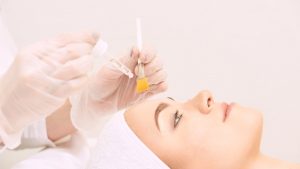
Chemical peels use a chemical solution to cause superficial trauma to the outermost skin layer so that the old tissue peels off, forcing the regeneration of newer, healthier skin tissue beneath. The regenerated skin tissue is smoother, tighter and healthier in appearance. The most common types of chemical peels use Alpha Hydroxy Acids, Beta Hydroxy Acids (also known as Salicylic Acids) or Retinoid Acids. Depending on the required intensity of the chemical peel best suited to your individual dermatologic needs, your dermatologist will suggest a superficial, medium or deep peel.
After receiving the in-office chemical peel, the patient’s skin will begin to blister and peel. Most patients describe the sensation as being similar to a sunburn. As the old layer of skin peels away, it will help reduce the appearance of acne scarring, age spots, crow’s feet, hyperpigmentation, sun damaged skin, melasma and wrinkles. Because of the use of chemicals to temporarily damage the outermost layer of the skin, it is recommended not to repeat this procedure too frequently and to avoid sun exposure for several weeks post-treatment so the new skin can heal completely.
